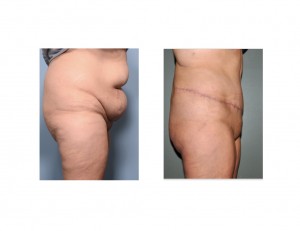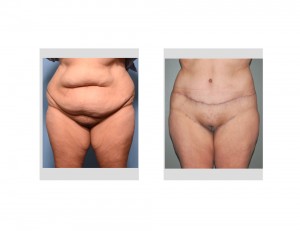Background: Tummy tuck surgery is one of the most popular of all body contouring surgeries. While it usually results in a hip to hip scar in a traditional tummy tuck surgery, most women consider this a very acceptable trade-off for the abdominal flattening result obtained. While the abdominal scar can have its own aesthetic issues such as placement, shape and width, scar revision can often make improvements if needed.
What many people do not realize is there are many different variations of tummy tuck surgery. It is often seen as an operation consisting of only a full and mini- tummy tuck choice. But that is a simplistic approach to an operation that has up to eight (8) different tummy tuck types. The choice of tummy tuck is determined by how much abdominal skin and fat need to be removed and haw far around into the back the excision need to be done.
The ‘double roll’ abdominal deformity consist of two distinct abdominal skin and fat rolls. The larger roll is at the lower abdominal area between the belly button and the pubic and creates varying degrees of waistline overhang. The smaller second roll lies above the belly button and creates a smaller overhang that partially obscures the belly button. The double roll abdominal deformity almost always result from moderate weight loss, although not necessarily from bariatric surgery
Case Study: This 42 year-old female wanted to improve her abdominal shape after multiple pregnancies and a 40 lb weight loss. She had lost about the most weight that she could and had hit the ‘wall’ when it came to making any further abdominal reduction/reshaping on her own.


Case Highlights:
1) The double roll abdominal deformity requires an extended tummy tuck to adequately remove the loose abdominal skin and fat and create a near flat abdomen.
2) The extended tummy tuck creates a long incision and resultant scar that goes beyond the hips onto the back.
3) The recovery from an extended tummy tuck is no longer than that from a traditional shorter scar tummy tuck.
Dr. Barry Eppley
Indianapolis, Indiana



